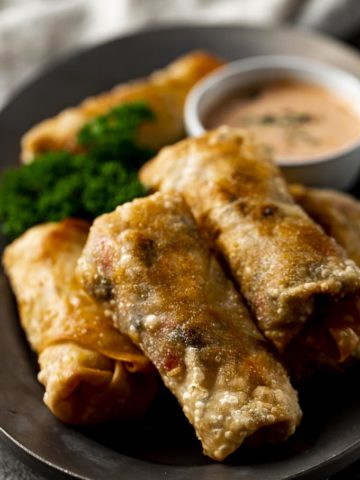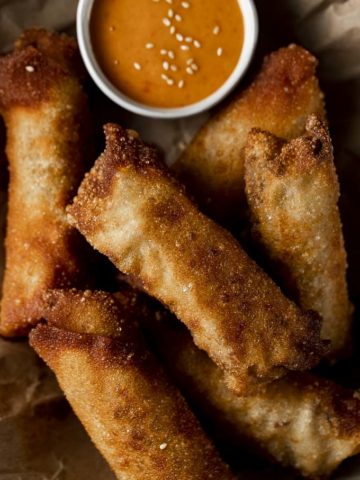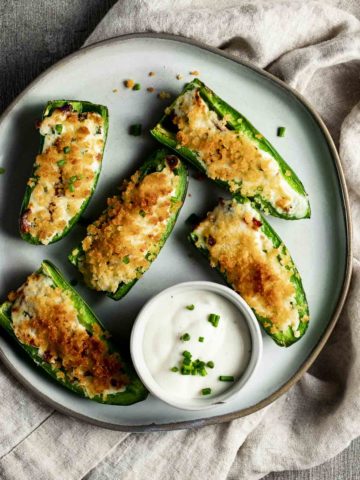This post may contain affiliate links. Please read my disclosure.
Learn how to make deliciously crispy Harumaki, or Japanese spring rolls, filled with a flavorful pork, shrimp, vegetable and vermicelli noodle filling. The perfect appetizer or party food!

We have fallen in love with the crispy exterior of these, and the ultra flavorful filling. I love that the glass noodles add a touch of chewy bite, while the pork keeps the filling juicy and delicious.
Somewhat similar to egg rolls or spring rolls (like these Vietnamese egg rolls), these crispy Japanese spring rolls are delicious and addictive (I challenge you to only eat one) and super convenient because they can be made in advance!
Jump to:
Why this harumaki recipe works
- While it takes a little practice to make harumaki, once you get the technique down these are easy to make and ALWAYS a crowd pleaser!
- The harumaki filling ingredients/proteins can be adjusted to your liking as needed.
- The filling can be made in advance, and the harumaki can also be rolled in advance and cooked when ready to serve.
- Using cornstarch in the filling thickens it up and makes it easier to roll in the harumaki wrappers.
Want to Save This Recipe?
Enter your email & I'll send it to your inbox. Plus, get great new recipes from me every week!
By submitting this form, you consent to receive emails from Went Here 8 This.
Ingredients for Japanese spring rolls

The full list of ingredients for harumaki and amounts is included in the recipe card at the bottom of the post.
Harumaki wrappers are very similar to spring roll wrappers, but they are made only with wheat flour and water, while spring roll or egg roll wrappers include egg as well. That said, these pastry wrappers can be difficult to find so I recommend using spring roll wrappers as a substitute.
Ground pork and shrimp are both used as the protein part of the filling. You can substitute all ground pork if you prefer to leave the shrimp out.
Vegetables like shiitake mushrooms, bamboo shoots, green onions, ginger, carrots, and cabbage are used along with cooked glass noodles (also called potato starch noodles) as a filler.
Step by step instructions
Step 1: Place the dried shiitake mushrooms in a bowl and cover with boiling water. Let them sit to soften for 30 minutes. Squeeze out water, remove stems and chop into small pieces, discarding the soaking liquid.




Step 6: Divide the filling into 15 equal parts to make the harumaki. Place a wrapper on a flat dry surface.
Step 7: Place one portion of the mixture in the corner of the harumaki (or spring roll) wrapper towards the center of the wrapper. Roll up halfway, folding the edge on each side inwards. Continue rolling.


Serve warm with ponzu dipping sauce or Japanese karashi mustard.

Serving options
- While the ponzu sauce and Japanese karashi mustard is delicious, I like them dipped in the Vietnamese dipping sauce (I know, I know, this is not traditional but it'd delicious!).
- Make it a appetizer extravaganza and serve it alongside some air fryer chicken karaage, temaki sushi, sushi bake or yakitori chicken thigh.
- Traditionally, they are not served with a dipping sauce, so feel free to just eat them as is - they are delicious!
Expert tips for making harumaki
- Substitute spring roll wrappers for the harumaki wrappers if you have trouble finding them.
- Use a mixture of 1 tablespoons of water and 1 tablespoon of cornstarch to seal the edge of the wrapper instead of plain water.
- Don't roll the harumaki too tight - keep them just slightly loose to allow them to stay airy and crisp and prevent them from bursting.
- Omit the shrimp if needed for allergy purposes. Substitute with additional pork. You can also substitute chicken or beef for the pork.
- Taste the cooked filling and add additional salt as needed.
- Keep the wrappers covered with a damp paper towel while you roll them as they will dry out quickly while sitting there.

Frequently asked questions
Harumaki is a Japanese spring roll made with a filling of ground pork, bamboo shoots, carrots, cabbage, mushrooms, and glass noodles, along with seasonings. The outside is crispy and the inside is moist and flavorful.
Basically, the difference is the egg roll skins are made with wheat, egg and water, while the harumaki skins are made with just wheat and water. The harumaki is thinner and as a result they are lighter and crisper than egg roll wrappers.
Japanese spring rolls tend to be lighter and crisper than Chinese egg rolls due to the use of harumaki wrappers. In addition, harumaki do not typically use garlic in the filling, while Chinese egg rolls do. Harumaki spring rolls have been adapted to Japanese tastes using Japanese cooking techniques.
Leftovers can be store in an airtight container in the fridge for up to 3 days. Reheat in a 400°F oven until warmed through. You can also reheat in a microwave, but the oven will result in crispier rolls.
Leftovers/premade rolls can also be frozen. Place rolls directly on a baking sheet and place in the freezer for 3 hours. Place the roll sin a freezer bag and store for up to 3 months. Defrost in the fridge overnight, then cook or reheat according to the recipe instructions or the reheating instructions above.
More egg roll recipes
If you love this recipe, please leave a star rating and a comment below and let us know your favorite thing about it. We'd also love to connect on Instagram! Follow us at @went_here_8_this for awesome recipes and all sorts of fun food stuff 🙂
Recipe

Harumaki (Japanese Spring Rolls)
Ingredients
- 15 harumaki sheets substitute spring roll wrappers
- Oil for deep frying vegetable, canola, peanut
- 1 ½ ounces dried glass noodles potato starch noodles, cooked to package instructions
- 4 dried shiitake mushrooms rehydrated and stems removed
- ¼ pound ground pork
- 3 ounces shrimp about 4-5 medium/large shrimp, finely minced
- 2 tablespoons soy sauce
- ¼ teaspoon white pepper
- 1 teaspoon salt
- 2 teaspoons cornstarch
- 2 teaspoon sake
- 2 ounces bamboo shoots thinly sliced
- 1 teaspoon fresh grated ginger
- 2 green onions white part only, finely chopped
- 1 tablespoon grated carrot
- ½ cup grated cabbage
- 1 teaspoon sesame oil
- Cornstarch slurry 2 tablespoons cornstarch mixed with 2 tablespoons water
Instructions
- Place the dried shiitake mushrooms in a bowl and cover with boiling water. Let them sit to soften for 30 minutes. Squeeze out water, remove stems and chop into small pieces, discarding the soaking liquid.
- Combine the pork, shrimp, soy sauce, white pepper, salt, 1 teaspoon cornstarch and sake in a bowl and mix well to combine. Let marinade for 30 minutes.
- Heat a skillet over medium heat and add the pork mixture.
- Cook for 3-5 minutes, until pork is no longer pink.
- Add the ginger, carrots, green onions, bamboo shoots, cabbage, shiitakes, and glass noodles and cook for 3-4 minutes.
- Stir in the sesame oil.
- Make the cornstarch slurry and slowly pour it in, mixing as you pour to distribute it throughout the mixture.
- Remove from heat and spread on a baking sheet to allow moisture to evaporate. Let the mixture cool completely (you can speed up cooling in the fridge).
- Divide the mixture into 15 equal parts.
- Place one portion of the mixture in the corner of the harumaki (or spring roll) wrapper towards the center of the wrapper.
- Roll up halfway, folding the edge on each side inwards. Continue rolling.
- Secure top corner with a dab of water or an equal cornstarch/water mixture to ensure it sticks together.
- Continue for all the harumaki rolls.
- Heat about 3 inches of oil to 350°F. Cook the harumaki, 5 at a time to ensure the temperature of the oil does not drop too much, until golden brown and crispy, about 3-5 minutes.
- Remove and place on a wire rack to drain. Continue with remaining 2-3 batches.
- Serve warm with ponzu dipping sauce or Japanese mustard.
Expert Tips:
- Substitute spring roll wrappers for the harumaki wrappers if you have trouble finding them.
- Use a mixture of 1 tablespoons of water and 1 tablespoon of cornstarch to seal the edge of the wrapper instead of plain water.
- Don't roll the harumaki too tight - keep them just slightly loose to allow them to stay airy and crisp and prevent them from bursting.
- Omit the shrimp if needed for allergy purposes. Substitute with additional pork. You can also substitute chicken or beef for the pork.
- Taste the cooked filling and add additional salt as needed.
- Keep the wrappers covered with a damp paper towel while you roll them as they will dry out quickly while sitting there.
Nutrition










Danielle says
So delicious!